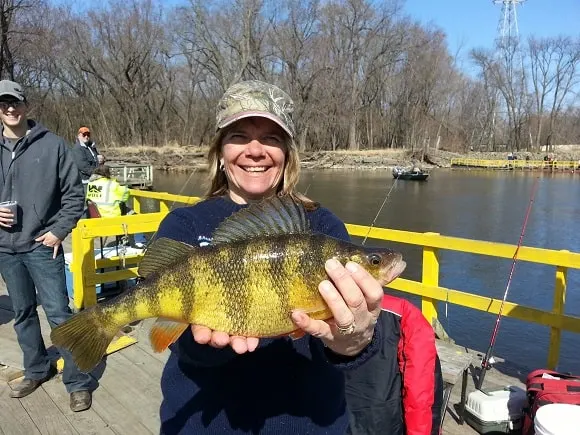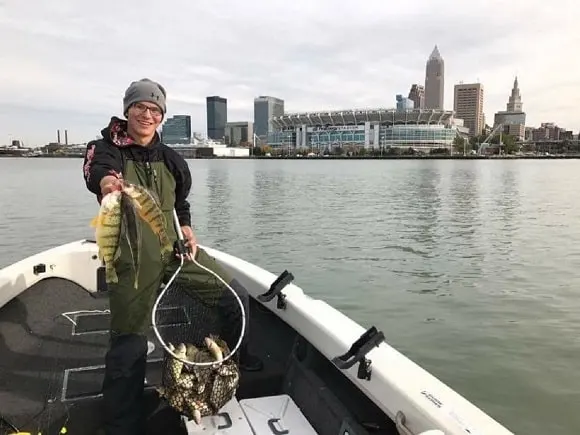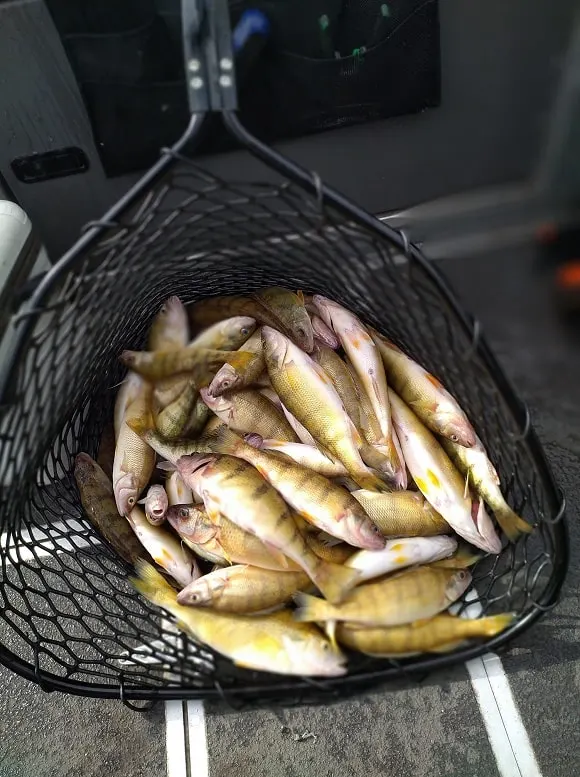The yellow perch is one of America’s most popular panfish. Despite being a relatively small fish species, it’s a ton of fun catching perch on light gear and tackle.
But what pound test is best for yellow perch? And what type of line should you use to catch this panfish species?
When fishing with a slip bobber rig, it’s best to use a monofilament mainline of 6 to 10lb. A braided mainline of around 6lb is your best choice when using small lures and jigs.
Want to learn more about the differences between mono and braid mainlines and get helpful and valuable tackle tips for yellow perch? Then make sure to keep reading this article!
What Fishing Line Should You Use for Yellow Perch?
Monofilament has always been the number one choice of line for yellow perch. It works for all techniques and has very low visibility underwater.
However, more and more anglers have also started to use thinner braid lines when targeting panfish like yellow perch.
Braided mainlines have become extremely thin, even at a greater pound test, so there is really no harm in using them for perch.
On the other hand, compared to mono lines, braid is expensive and could be considered a little overkill for a small fish species like the yellow perch.
Ultimately, the choice is, of course, yours!
But when should you use mono over braid and vice versa? Does it even make a difference?
When to Use Monofilament?

As I’ve already mentioned, monofilament line is never wrong when fishing for yellow perch.
Historically, anglers have always used this type of line for panfish, and it totally gets the job done!
However, monofilament line is best used when fishing with a slip bobber rig.
A low-pound test mono line is practically invisible underwater, which is essential when fishing statically with a slip bobber rig presentation.
If you don’t pitch your bobber rig, the fish will have plenty of time to observe it. And the last thing you want is for them to spot your mainline!
Another advantage of using a monofilament mainline is that is has some stretch to it.
Especially when fishing with small live baits, this can be a huge advantage regarding the hookset.
When fishing a slip bobber rig, you can’t always strike and set the hook immediately, as you would with a lure or jig, as there is no direct connection to the fish.
So when the fish tares at your hookbait or jig, the mono’s stretch will compensate and acts as a buffer, keeping the hook in the fish’s mouth until you set it.
Due to the lack of stretch in braid, the fish often rips itself free from the baited hook before you get the chance to strike.
When to Use Braid?

If you instead fish for yellow perch with small lures, like crankbaits, spoons, spinners, softbaits, or jigs, using a braided mainline is often the far better tackle choice.
Here, the braid’s zero-stretch feature becomes a big advantage for you.
You’ll get much more sensitivity with braid, helping you to feel any little tug and bite and setting the hook super fast.
I was skeptical of putting braid on for many years, especially for smaller species like perch, but once I tried it, it was a total game changer!
The feel you get with a thin braid is unreal and impossible to achieve with mono, no matter how light it may be.
Perch especially can be extremely finicky, so using a braided mainline is essential for bite detection. You’ll lose far fewer fish!
PRO TIP: The same goes for fishing in greater depths, by the way! Braid will keep that direct connection between you and the fish, no matter how deep you present your lure!
Additionally, braid is much stronger than monofilament line, even at a very low diameter.
This strength helps with both snags and bigger fish that might go after your lures!
Who hasn’t caught a big pike or bass on a tiny spinner or crankbait, right?
If you have braid on your spool, chances are good that you will land those occasional bonus fish without much of a problem instead of losing your entire setup!
Now, let’s have a closer look at some of the best mono and braid lines for yellow perch!
What Is the Best Monofilament Line for Yellow Perch?
KastKing has quickly evolved from a newcomer to a popular and established fishing gear brand with a wide range of products, including quality fishing lines.
The KastKing World’s Premium Monofilament is the perfect proof of that!
This mono line has become insanely popular and is now the top pick of thousands and thousands of US anglers targeting a great variety of game fish.
Panfish anglers swear by it and appreciate the line’s excellent performance and affordable price.
Available in different colors and pound tests, the KastKing World’s Premium Monofilament also has the following great features:
- Super-low memory for easy handling, casting, and retrieving
- High abrasion resistance
- Low absorption
- Great knot strength
This is the perfect mono line for your perch adventures. And honestly, for the price (300 yards sell at about $10), you probably won’t find a better mono line!
Take a closer look at the incredible KastKing World’s Premium Monofilament on Amazon here
What Pound Test Monofilament Is Best for Yellow Perch?
In most situations, a mono line with a 6lb test will be perfect for yellow perch.
If you’re fishing in open, snag-free water and there is no risk of hooking up to larger predators, a 4-pound test will also suffice.
If, on the other hand, you’re fishing in or close to heavy cover and there are bass, walleye, pike, or any other larger game fish around, upping that to an 8 or 10-pound test is probably a wise choice!
What Is the Best Braid for Yellow Perch?
The Sufix 832 is one of the best braids on the market today, for perch or any other type of freshwater fish!
I use this line myself and have only positive things to say about it.
Fishing with a quality braid of the proper pound test will not only optimize your fishing and catch you more fish, but it’s also a very fun experience because you’re so much more aware of what’s happening beneath the surface!
The Sufix 832 is the perfect example of that; a high-quality line with an incredible diameter-to-strength ratio that will next-level your fishing experience, guaranteed.
Here are some of the Sufix 832’s best features:
- 8 fiber braid for ultimate performance
- Incredible strength
- High abrasion resistance (especially for a braid!)
- Great castability
- Low-vis green color (very camo, which is excellent for perch)
I especially like the dark moss-green color of this braid, as it’s exceptionally stealthy underwater.
All in all, one of the best braided mainlines out there! And one that is very decently priced, by the way!
Go check out the Sufix 832 Braid on Amazon right now
What Pound Test Braid Is Best for Yellow Perch?
When fishing in open water with no or minimal risk for snags and bigger predators, you can use a 6-pound test braid for yellow perch.
On the contrary, if you’re targeting areas with heavy cover or sharp features (like rocks or zebra mussels), you should use a much higher pound test!
Braid doesn’t do well against sharp edges, so a 20lb test is a good option, even though it sounds thick.
The diameter of the 20-pound test Sufix is equal to a 6lb mono line. That means the perch won’t spot your line, and you’re relatively safe fishing in those snaggy areas with sharp features.
And if you happen to hook up to a real pike or bass monster, well, then fighting and landing that fish won’t be an issue either! Win-win!
Are Yellow Perch Line Shy?

Perch are sight feeders, and as such, they have perfect eye vision, even in lower-visibility conditions.
That means they can see your mainline if it is too thick or visible and potentially spook.
So make sure you use the pound test mono and braid lines recommended in this article! It can make a lot of difference underwater.
Should You Use a Leader for Yellow Perch Fishing?
When fishing with a thin monofilament line, a fluorocarbon leader is often unnecessary, especially if you’re using clear-colored mono.
You can just run your mono mainline straight down to your hook.
Unless you’re fishing in or near heavy cover and get snagged a lot. Then, topping your mainline with a somewhat thinner FL leader can be a good idea.
If you get snagged, the leader breaks, and you’ll lose your hook and bait. But you will keep your slip bobber!
On the other hand, a fluorocarbon leader is basically always a good idea when fishing with braid.
With a braided mainline, visibility can be an issue.
The easiest way to prevent the fish from spotting your mainline is by using a long enough fluorocarbon leader, as this line material is more or less completely invisible underwater.
Make sure your FC leader is at least 2 to 3 feet long, and you won’t have any problems getting bites, even in clear water conditions!
Related Articles
- Best Lines for Crappie Fishing
- What Is the Best Fluorocarbon Leader for Walleye?
- How to Rig a Slip Bobber? (Easy Step-By-Step Guide)
Featured image courtesy of Jon Bowlus



